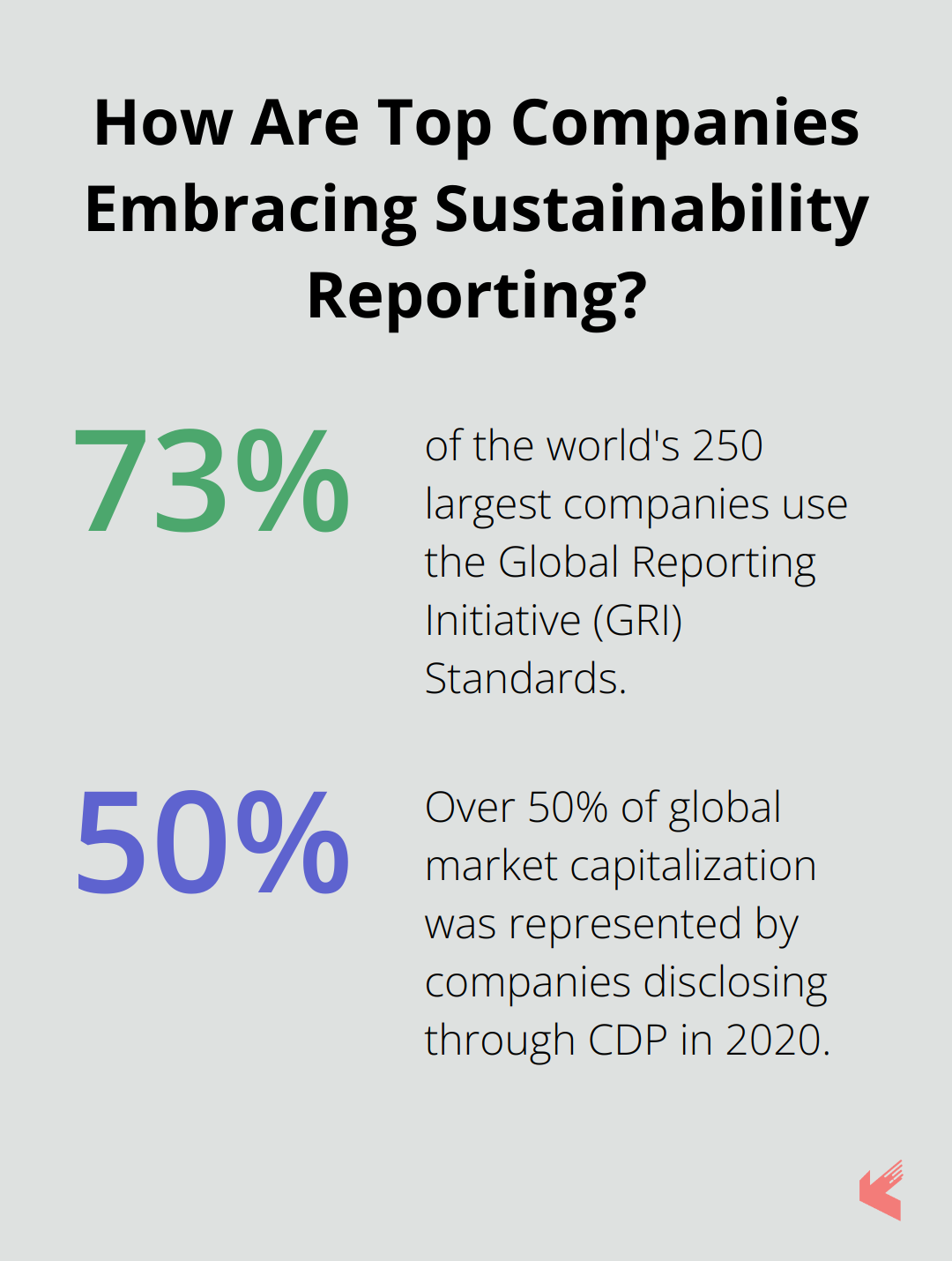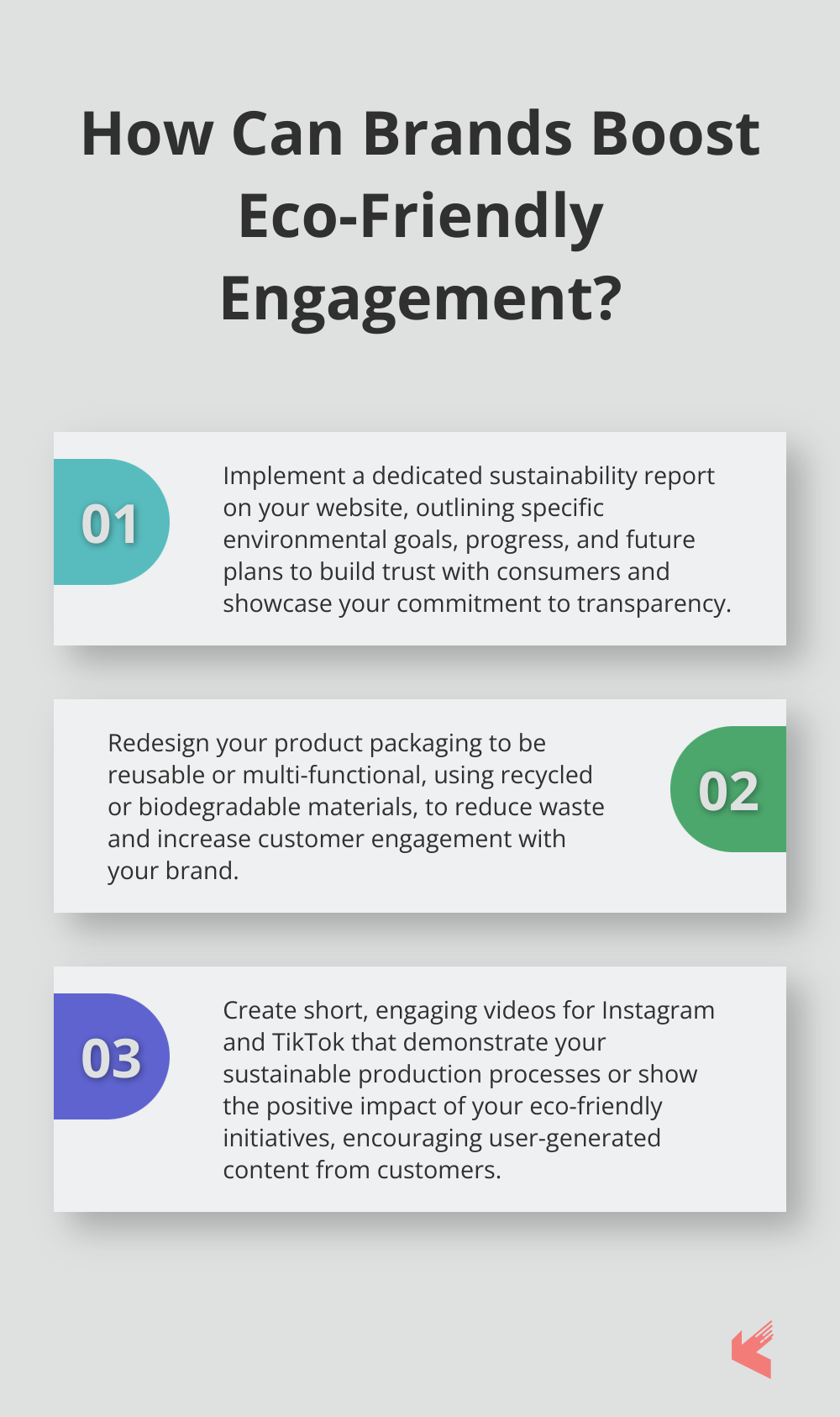Le marketing écologique est en train de remodeler le paysage commercial. Les consommateurs exigent de plus en plus des marques qu'ils soutiennent des produits et des pratiques durables.
Chez Karma Works Marketing, nous avons constaté de première main que les stratégies de marketing écologique peuvent renforcer la réputation d'une marque et stimuler les ventes. Cet article de blog explore les tactiques efficaces permettant aux marques durables d'entrer en contact avec les consommateurs soucieux de l'environnement et d'avoir un impact positif.
L'importance d'un Marketing respectueux de l'environnement
L'évolution des préférences des consommateurs
Le marketing écologique dépasse les mots à la mode ; il s'agit d'une stratégie puissante qui aligne les objectifs commerciaux sur la responsabilité environnementale. Cette approche permet de promouvoir des produits ou des services en fonction de leurs avantages pour l'environnement. Le paysage commercial actuel exige ce changement pour plusieurs raisons impérieuses.

Les préférences des consommateurs se sont rapidement transformées. Une étude de First Insight révèle que 62% des acheteurs de la génération Z préfèrent acheter des produits de marques durables et 73% sont prêts à payer plus cher pour des produits durables. Cette tendance n'est pas éphémère. Selon Nielsen, 73% des consommateurs mondiaux changeraient leurs habitudes de consommation pour réduire leur impact sur l'environnement.
Les marques qui communiquent de manière authentique sur leurs pratiques respectueuses de l'environnement bénéficient d'une fidélité et d'un engagement accrus de la part de leurs clients. Les consommateurs votent désormais avec leur portefeuille, choisissant les entreprises qui s'alignent sur leurs valeurs.
L'avantage commercial de la durabilité
L'adoption d'un marketing respectueux de l'environnement est bénéfique à la fois pour la planète et pour les résultats financiers. Une étude de McKinsey a montré que les entreprises axées sur le développement durable avaient deux fois plus de chances d'augmenter leur chiffre d'affaires de 10% que leurs concurrents. Cette constatation rejoint celle de Forbes, selon laquelle plus de 88% des consommateurs restent fidèles aux marques qui font preuve d'un véritable engagement en faveur de l'environnement.
L'authenticité : La clé du succès de l'Eco-Marketing
Le marketing écologique ne se limite pas à l'apposition d'un label "vert" sur les produits. Les consommateurs avertis d'aujourd'hui peuvent facilement détecter l'écoblanchiment (déclarations environnementales fausses ou trompeuses). Un marketing écologique authentique nécessite une approche holistique, allant du développement de produits durables à une communication transparente sur les pratiques environnementales.
Patagonia place la barre très haut avec son initiative Worn Wear, qui encourage les clients à échanger leurs vêtements usagés. Ce programme permet non seulement de prolonger la durée de vie des produits, mais il témoigne également d'un véritable engagement en faveur de la réduction de l'impact sur l'environnement.
Le rôle de l'innovation dans le développement durable Marketing
L'innovation joue un rôle essentiel dans le marketing écologique. Les entreprises doivent continuellement développer de nouveaux moyens de réduire leur empreinte environnementale et de communiquer efficacement sur leurs efforts. Par exemple, Pela (un fabricant d'étuis de téléphone durables) utilise matériaux biodégradables dans leurs produits, démontrant ainsi que l'innovation peut favoriser la durabilité dans des secteurs inattendus.
L'avenir du Marketing écologique
Alors que les consommateurs sont de plus en plus sensibilisés et que les défis environnementaux persistent, le marketing respectueux de l'environnement deviendra de plus en plus important. Les marques qui ne s'adaptent pas risquent de perdre des parts de marché au profit de concurrents plus soucieux de l'environnement. Le chapitre suivant examinera les stratégies spécifiques marques durables peuvent utiliser pour entrer en contact avec les consommateurs soucieux de l'environnement et avoir un impact positif.
Comment mettre en œuvre des stratégies Marketing efficaces et respectueuses de l'environnement ?
Le marketing écologique nécessite une approche globale qui va au-delà des affirmations superficielles. Plusieurs stratégies clés peuvent aider les marques durables à communiquer efficacement leur engagement environnemental et à se rapprocher des consommateurs soucieux de l'environnement.
Authenticité et transparence dans les messages
Les consommateurs sont de plus en plus sceptiques à l'égard de l'écoblanchiment, ce qui rend l'authenticité essentielle dans le marketing écologique. Les marques doivent être transparentes sur leurs efforts en matière de développement durable, y compris sur leurs succès et leurs difficultés.
Par exemple, la campagne "Don't Buy This Jacket" (N'achetez pas cette veste) de Patagonia s'est attaquée avec audace à la surconsommation tout en soulignant l'engagement de l'entreprise en faveur d'une production durable.
Pour instaurer la confiance, fournissez des informations détaillées sur vos pratiques écologiques sur votre site web et sur l'emballage de vos produits. Envisagez de créer un rapport sur le développement durable qui décrive vos objectifs environnementaux, vos progrès et vos projets futurs.
Soyez honnête sur les points que vous devez encore améliorer, car cette transparence peut renforcer votre crédibilité auprès des consommateurs.
Emballages et matériaux innovants
Les emballages écologiques ne sont plus facultatifs pour les marques durables. A étude de Trivium Packaging a révélé que 82% des consommateurs sont prêts à payer plus cher pour un emballage durable. Essayez d'utiliser des matériaux recyclés ou biodégradables pour vos produits et votre matériel d'expédition.
Lush Cosmetics a été le pionnier de l'emballage "nu", en vendant de nombreux produits sans aucun emballage. Cette approche permet non seulement de réduire les déchets, mais elle constitue également un puissant outil de marketing qui distingue la marque dans le secteur de la beauté.
Lors de la refonte de vos emballages, ne vous contentez pas de penser aux matériaux. Réfléchissez à la manière dont vous pouvez rendre votre emballage réutilisable ou multifonctionnel. Cela permet non seulement de réduire les déchets, mais aussi d'accroître l'engagement des clients à l'égard de votre marque.
Tirer parti de Social Media pour raconter des histoires sur le développement durable
Les plateformes de médias sociaux offrent des outils puissants pour mettre en valeur vos efforts en matière de développement durable. Utilisez ces canaux pour partager les coulisses de vos pratiques respectueuses de l'environnement, souligner l'implication des employés dans les initiatives de développement durable, et éduquer les consommateurs aux questions environnementales en rapport avec votre secteur d'activité.
Instagram et TikTok sont particulièrement efficaces pour la narration visuelle.
Créez des vidéos courtes et attrayantes qui démontrent vos processus de production durables ou l'impact positif de vos initiatives écologiques. Encouragez le contenu généré par les utilisateurs en demandant aux clients de partager la façon dont ils utilisent vos produits de manière durable.
Partenariats et collaborations stratégiques
Collaborer avec des organisations environnementales et des éco-influenceurs peut amplifier votre message de durabilité et donner de la crédibilité à vos efforts. Recherchez des partenariats qui correspondent aux valeurs de votre marque et qui peuvent avoir un impact significatif.
Par exemple, la marque de vêtements de plein air Timberland s'est associée à la Smallholder Farmers Alliance en Haïti pour créer une chaîne d'approvisionnement durable en coton. Ce partenariat a non seulement permis d'améliorer la durabilité de leurs produits, mais a également fourni une histoire convaincante pour leurs efforts de marketing.
Lors de la sélection des influenceurs, donnez la priorité à ceux qui s'engagent véritablement en faveur de la durabilité plutôt qu'à ceux qui ont le plus d'adeptes. Les micro-influenceurs dans le domaine de l'écologie ont souvent un public très engagé qui est plus susceptible de répondre à votre message.
Campagnes Marketing pour une cause importante
Les campagnes de marketing d'intérêt général peuvent être des outils puissants pour les marques durables, mais elles doivent être exécutées de manière réfléchie. Choisissez des causes qui correspondent étroitement aux valeurs de votre marque et à votre offre de produits. Par exemple, si vous êtes une marque de mode durable, vous pourriez vous associer à des organisations qui travaillent à la réduction des déchets textiles ou à l'amélioration des conditions de travail dans les usines de confection.
Givz (une plateforme qui permet aux marques de proposer des dons après l'achat) rapporte que les marques participantes constatent une augmentation de 90% des conversions sur leur site web. Envisagez de mettre en œuvre des initiatives similaires permettant aux clients de contribuer à des causes environnementales par le biais de leurs achats.
Le marketing caritatif doit être un engagement à long terme, et non une campagne ponctuelle. Soutenez constamment les causes que vous avez choisies et informez régulièrement vos clients de l'impact de leurs contributions.
La mise en œuvre de ces stratégies peut aider les marques durables à communiquer efficacement sur leurs pratiques écologiques et à gagner la confiance des consommateurs. À mesure que nous avançons, il est important de réfléchir à la manière de mesurer ses efforts et s'adapter en conséquence. Le chapitre suivant explore les indicateurs clés de performance et les méthodes d'analyse pour évaluer le succès de vos stratégies de marketing durable.
Quantifier le succès d'Eco-Marketing
ICP spécifiques au développement durable
Un suivi efficace du succès de l'écomarketing nécessite la mise en place d'indicateurs clés de performance (ICP) spécifiques au développement durable. Ces indicateurs peuvent inclure la réduction de l'empreinte carbone, les taux de détournement des déchets ou le pourcentage de matériaux recyclés utilisés dans les produits. Unilever, par exemple, suit le nombre de ses marques qui sont certifiées durables par un organisme indépendant (l'objectif étant d'atteindre 100% d'ici à 2030).

La consommation d'énergie est un autre ICP essentiel. IKEA surveille ses progrès en matière d'utilisation d'énergie renouvelable (100%) dans l'ensemble de ses activités. Les marques devraient également suivre la consommation d'eau, en particulier dans les secteurs à forte consommation d'eau comme le textile ou la production alimentaire.
Les indicateurs relatifs à la clientèle sont tout aussi importants. Surveillez les ventes des lignes de produits respectueuses de l'environnement par rapport aux alternatives conventionnelles. Suivez l'engagement des clients à l'égard du contenu lié au développement durable sur votre site web et vos canaux de médias sociaux. Mesurez le nombre de clients qui participent à des initiatives de développement durable telles que des programmes de recyclage ou de compensation des émissions de carbone.
Analyse de la perception de la marque
La perception des consommateurs indique le succès du marketing écologique. Des enquêtes régulières et des outils d'écoute sociale permettent d'évaluer la façon dont les clients perçoivent les efforts de votre marque en matière de développement durable. Le Net Promoter Score (NPS) spécifiquement lié au développement durable peut fournir des informations précieuses.
L'analyse des sentiments des mentions dans les médias sociaux et des commentaires des clients révèle l'efficacité de votre messages respectueux de l'environnement résonne avec votre public. Des outils comme Brandwatch ou Sprout Social peuvent automatiser ce processus.
Suivre l'évolution de la fidélité à la marque et de la valeur de la durée de vie du client parmi les consommateurs soucieux de l'environnement. Une étude du Center for Sustainable Business de la NYU Stern a révélé que les produits commercialisés dans le cadre du développement durable ont connu une croissance 5,6 fois plus rapide que les produits commercialisés de manière conventionnelle.
Retour sur investissement des initiatives écologiques
Le calcul du retour sur investissement (RSI) des initiatives respectueuses de l'environnement nécessite une approche globale. Il faut tenir compte à la fois des impacts financiers directs et des bénéfices indirects.
Les impacts financiers directs peuvent inclure des économies de coûts liées à la réduction de la consommation d'énergie ou à la réduction des déchets. Les avantages indirects pourraient comprendre l'amélioration de la réputation de la marque, la fidélisation de la clientèle et l'amélioration de la satisfaction et de la fidélisation des employés.
L'investissement de Patagonia dans des produits durables et réparables a d'abord semblé aller à l'encontre d'une augmentation des ventes. Cependant, cette stratégie a permis de fidéliser la clientèle et de connaître une croissance régulière (les recettes ont atteint $1 milliard en 2017).
Lorsque vous calculez le retour sur investissement, tenez compte de l'atténuation potentielle des risques. À mesure que les réglementations environnementales se durcissent, les marques qui ont des pratiques solides en matière de développement durable sont mieux placées pour s'adapter, évitant ainsi des amendes potentielles ou des perturbations opérationnelles.
Exploiter les cadres de présentation des rapports
Les cadres de reporting sur le développement durable apportent structure et crédibilité à vos efforts d'éco-marketing. Les normes de la Global Reporting Initiative (GRI) sont largement reconnues et utilisées par 73% des 250 plus grandes entreprises du monde.
Le Sustainability Accounting Standards Board (SASB) propose des normes spécifiques à l'industrie qui peuvent aider à identifier les sujets importants en matière de développement durable pour votre entreprise. Ces cadres ne se contentent pas d'orienter les mesures internes, ils facilitent également la mise en œuvre de la politique de développement durable de l'entreprise. la communication avec les parties prenantes.
La divulgation des émissions de carbone est devenue de plus en plus importante. Le CDP (anciennement Carbon Disclosure Project) fournit un cadre complet pour la déclaration de l'impact environnemental. En 2020, plus de 9 600 entreprises ont divulgué des informations par l'intermédiaire du CDP, ce qui représente plus de 50% de la capitalisation boursière mondiale.
Réflexions finales
Le marketing écologique est devenu la pierre angulaire de la stratégie des entreprises modernes. Les préférences des consommateurs et l'urgence environnementale sont à l'origine de cette évolution, récompensant les marques durables par une plus grande fidélité et de meilleures performances financières. Les entreprises qui accordent la priorité à la responsabilité écologique se positionnent pour réussir sur un marché dominé par des consommateurs soucieux de l'environnement.

Un marketing écologique efficace nécessite une approche holistique qui englobe tous les aspects d'une entreprise. La transparence, l'innovation et l'engagement sincère permettent d'instaurer un climat de confiance avec les consommateurs exigeants d'aujourd'hui. La mesure et le compte rendu des efforts en matière de développement durable permettent aux marques d'affiner leurs stratégies et de démontrer un impact tangible.
Chez Karma Works Marketing, nous comprenons la complexité de la navigation dans ce paysage en évolution. Notre expertise en Stratégies de marketing respectueuses de l'environnement peut aider les marques durables à communiquer efficacement leur engagement environnemental. Les entreprises doivent adopter pleinement les pratiques durables pour rester compétitives et apporter des changements positifs sur le marché de demain.

